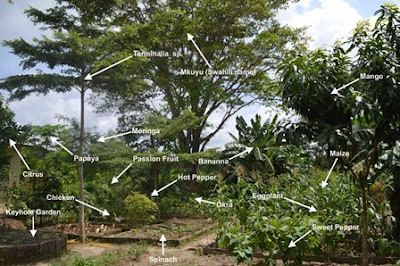PDC LESSON 2.37 DESIGN – A LASAGNA GARDEN BED IS NO DIG, NO TILL
PDC LESSON 2.37 DESIGN – A LASAGNA GARDEN BED IS NO DIG, NO TILL
This is a great no-dig, no-till organic gardening method that will give you rich soil, and best of all, it's easy to build & maintain. The name "Lasagna Gardening" is the method of building the garden. You will add layers of organic material that “decompose” over time, and the result will be soil that will help your plants thrive. It's great for the environment, because you use your yard and kitchen waste, and then compost it to make a new garden.
If you don't feel like doing
all the Garden work later to get ready to plant your Spring Garden, then this
might be for you.....One of the best things about Lasagna Gardening is how easy
it is. You don't have to remove existing sod and weeds from your Garden. You
don't have to double dig. In fact, you don't have to work the soil at all. The
first layer of your Lasagna Garden consists of cardboard laid directly on top
of the grass or weeds in the area you've selected for your garden. Wet this
layer down to keep everything in place and start the decomposition process.
The grass or weeds will break
down quickly because they will be smothered by the cardboard, as well as by the
materials you're going to layer on top of them. This layer also provides a
dark, moist area to attract earthworms that will loosen up the soil as they
tunnel through it.
Anything you'd put in a
compost pile, you can put into a Lasagna Garden. The materials you put into the
garden will break down, providing nutrient-rich, crumbly soil in which to
plant.
The following materials are
all perfect for Lasagna Gardens:
Leaves
Grass Clippings
Fruit and Vegetable Scraps
Coffee Grounds
Tea leaves/ tea bags
Weeds
Manure
Compost
Hay or Straw
Shredded newspaper or mail
Pine needles
Trimmings from the garden
You'll want to alternate layers of “BROWNS” such as leaves shredded newspaper, peat, and pine needles with layers of “GREENS” such as vegetable scraps, garden trimmings, and grass clippings. In general, you want your "brown” layers to be about twice as deep as your “green” layers. What you want at the end of your layering process is a two-foot tall, layered bed. You'll be amazed at how much this will shrink down in a few short weeks.
You can make a Lasagna Garden
at any time of year. To maintain the garden, simply add mulch to the top of the
bed in the form of straw, grass clippings, or chopped leaves. Once it's
established, you will care for a lasagna garden just as you would any other.
While you will be maintaining it the same way you would care for any other
garden, you will find that caring for a Lasagna Garden is less work-intensive.
You can expect:
FEW WEEDS.....
thanks to the cardboard
suppressing them from below and the mulch covering the soil from above.
BETTER WATER RETENTION.....
due to the fact that compost
(which is what you made by layering all of those materials) holds water better
than regular garden soil, especially if your native soil is sandy or deficient
in organic matter.
LESS NEED TO HAVE TO
FERTILIZE.....
because you planted your
garden in almost pure compost, which is very nutrient-rich.
SOIL EASY TO WORK.....
crumbly, loose, and fluffy.
Lasagna Gardening is fun,
easy, and allows you to make a new Garden at a
much faster rate than the old double-digging method.



Comments
Post a Comment